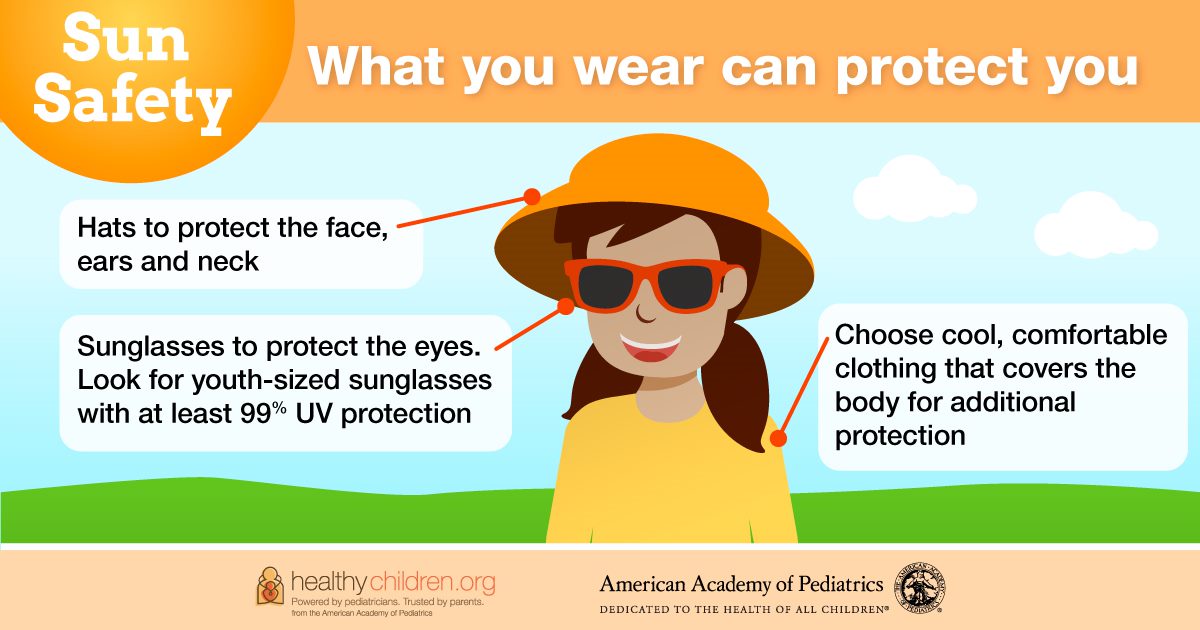Warm, sunny days are wonderful. It's good for children to spend time playing and exercising
outdoors, and it's important they enjoy it safely. Here are some tips on how to help keep your family safe from too much exposure to the sun's harmful rays.
Simple rules to protect your family from sunburns
Keep
babies younger than 6 months out of direct sunlight. Find shade under a tree, an umbrella, or the stroller canopy.
Dress yourself and your children in cool, comfortable clothing that covers the body when possible. Think lightweight cotton pants, long-sleeved shirts and hats.
Select clothes made with a tight weave, which protect better than clothes with a looser weave.
Tip: If you're not sure how tight a fabric's weave is, hold it up to see how much light shines through. The less light, the better. Or you can look for protective clothing labeled with an Ultraviolet Protection Factor (UPF).
Wear a hat with an all-around 3-inch brim to shield the face, ears, and back of the neck.
Limit your sun exposure between 10:00 a.m. and 4:00 p.m., when UV rays are strongest.
Wear sunglasses with at least 99% UV protection. Look for youth-sized sunglasses with UV protection for your child.
Use sunscreen (see more below).
Make sure everyone in your family knows how to protect their skin and eyes. Remember to set a good example by practicing sun safety yourself.

Sunscreen
Sunscreen can help protect the skin from sunburn and some
skin cancers but only if used correctly. Keep in mind that sunscreen should be used for sun protection, not as a reason to stay in the sun longer.
How to choose a sunscreen
Use a sunscreen that says "broad-spectrum" on the label; that means it will screen out both UVB and UVA rays.
Use a broad-spectrum sunscreen with a sun protection factor (SPF) of at least 15 (up to SPF 50). An SPF of 15 or 30 should be fine for most people. More research studies are needed to test if sunscreen with more than SPF 50 offers any extra protection.
If possible, avoid the sunscreen ingredient oxybenzone because of concerns about mild hormonal properties. Remember, though, that it's important to take steps to prevent
sunburn, so using any sunscreen is better than not using sunscreen at all.
For sensitive areas of the body, such as the nose, cheeks, tops of the ears and shoulders, choose a sunscreen with zinc oxide or titanium dioxide. These products may stay visible on the skin even after you rub them in, and some come in fun colors that children enjoy.
How to apply sunscreen
Use enough sunscreen to cover all exposed areas, especially the face, nose, ears, feet, hands and even backs of the knees. Rub it in well.
Put sunscreen on 15 to 30 minutes before going outdoors. It needs time to absorb into the skin.
Use sunscreen any time you or your child spend time outdoors. Remember that you can get sunburn even on cloudy days because up to 80% of the sun's UV rays can get through the clouds. Also, UV rays can bounce back from water, sand, snow, and concrete, so make sure you're protected.
Reapply sunscreen every 2 hours and after
swimming, sweating or drying off with a towel. Because most people use too little sunscreen, make sure to apply a generous amount.
Sunscreen for babies
For babies younger than 6 months: Use sunscreen on small areas of the body, such as the face, if protective clothing and shade are not available.
For babies older than 6 months: Apply to all areas of the body, but be careful around the eyes. If your baby rubs sunscreen into their eyes, wipe their eyes and hands clean with a damp cloth. If the sunscreen irritates their skin, try a different brand or sunscreen with titanium dioxide or zinc oxide. If your baby develops a rash, talk with their doctor.
Sunburns
When to call the doctor
If your baby is younger than 1 year old and gets sunburn, call your their doctor right away. For older children, call your child's doctor if there is blistering, pain or
fever.
How to soothe sunburn
Here are 5 ways to relieve discomfort from mild sunburn:
Give your child
water or milk to replace lost fluids.
Use cool water to help your child's skin feel better.
Give your child
pain medicine to relieve painful sunburns. (For a baby 6 months or younger, give acetaminophen. For a child older than 6 months, give either acetaminophen or ibuprofen.)
Only use medicated lotions if your child's doctor says it is OK.
Keep your child out of the sun until the sunburn is fully healed.
Remember
The sun gives energy to all living things on earth, but it can also harm us. Its ultraviolet (UV) rays can damage skin and eyes and cause skin cancer. One-quarter of our lifetime sun exposure happens during childhood and adolescence.
Since children spend a lot of time outdoors, especially in the summer, it's important to protect them from the sun. Talk with your pediatrician if you have any questions about sun protection for your child.
More information